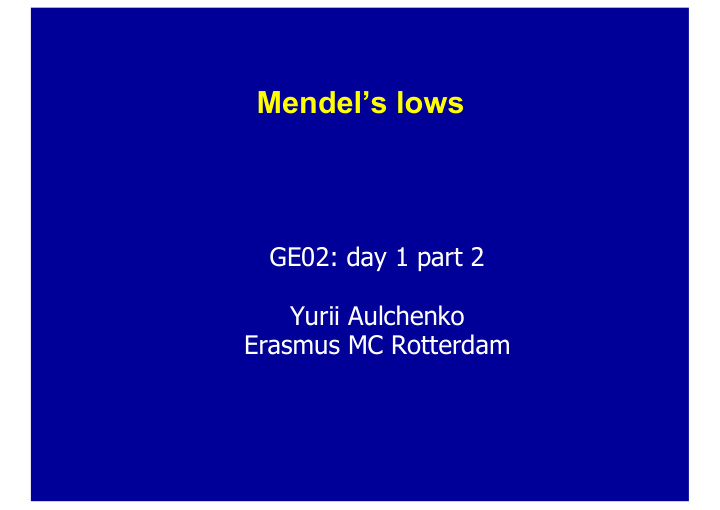



Mendel’s lows GE02: day 1 part 2 Yurii Aulchenko Erasmus MC Rotterdam
Gregor J. Mendel (1822 – 1884) 1865: talk on “Experiments on Plants Hybridisation” at two meetings of the Natural History Society of Brunn Mendel, G., 1866, Versuche über Pflanzen-Hybriden. Verh. Naturforsch. Ver. Brünn 4: 3–47 Yurii Aulchenko GE02, Oct 18 – Nov 12, 2010
Re-discovery of Mendel’s lows Hugo de Vries (March 1900) Sur la loi de la disjonction des hybrides // Competes Redus, CXXX no. 13: pp. 845-847 Hugo de Vries (March 1900) Das Spaltungsgsetz der Bastarde // Berichte der deutschen botanischen Gesellschaft, Bd XVIII: pp. 83-90 Carl Correns (April 1900) G. Mendel’s Regels ueber das Verhalten der Nachkommenschaft der Rassenbastarde // Berichte der deutschen botanischen Gesellschaft, Bd XVIII: pp. 158-168 Erich Tschermak (June 1900) Ueber kuenstliche Kreuzung bei Pisum sativum // Berichte der deutschen botanischen Gesellschaft, Bd XVIII: pp. 232-239 Yurii Aulchenko GE02, Oct 18 – Nov 12, 2010
Mendel’s Experiments The experimental plants must necessarily: Possess constant differentiating characteristics The hybrids of such plants must, during the flowering period, be protected from the influence of all foreign pollen, or be easily capable of such protection. The hybrids and their offspring should suffer no marked disturbance in their fertility in the successive generations. Yurii Aulchenko GE02, Oct 18 – Nov 12, 2010
Traits studied Seed’s form (round or wrinkled) Seed’s color (yellow or green) Seed-coat’s color (white or colored) Flower’s position (axial or terminal) Length of stem (6-7 ft vs. ¾ -1 ft.) … (7 in total) Some 28,000 pea plants tested Yurii Aulchenko GE02, Oct 18 – Nov 12, 2010
Uniformity of F 1 all yellow all green Yurii Aulchenko GE02, Oct 18 – Nov 12, 2010
Uniformity of F 1 , independent segregation in F 2 all yellow all green Yurii Aulchenko GE02, Oct 18 – Nov 12, 2010
Uniformity of F 1 , independent segregation in F 2 all yellow all green Yurii Aulchenko GE02, Oct 18 – Nov 12, 2010
Mendel’s low is based on one assumption Concepts Alleles : Y , G Y is dominant over G Genotype : Phenotype YY : Yellow YG or GY : Yellow GG : Green Assumption Alleles are transmitted to the next generation in random, independent manner Yurii Aulchenko GE02, Oct 18 – Nov 12, 2010
Uniformity of F 1 Yellow parental form has genotype YY Green parental form has genotype GG In F 1 all plants have genotype YG Y from Yellow parent and G from Green parent All F 1 will be Yellow . Yurii Aulchenko GE02, Oct 18 – Nov 12, 2010
Segregation in F 2 According to random transmission assumption YG plants will produce 50% Y and 50% G gametes. These will randomly aggregate to give F 2 : P( Y & Y ) = P( Y ) P( Y ) = ½ ½ = ¼ ( Yellow ) P( Y & G ) = P( Y ) P( G ) = ½ ½ = ¼ ( Yellow ) P( G & Y ) = P( G ) P( Y ) = ½ ½ = ¼ ( Yellow ) P( G & G ) = P( G ) P( G ) = ½ ½ = ¼ ( Green ) Thus ¾ will be Yellow and ¼ will be Green 3:1 established Yurii Aulchenko GE02, Oct 18 – Nov 12, 2010
Problem Consider two independent traits Seed’s color, as in previous example and Seed’s shape (wrinkled or smooth), which is controlled by alleles W and S, with S being dominant You cross smooth yellow to wrinkled green What is expected trait distribution in F 1 and F 2 ? Yurii Aulchenko GE02, Oct 18 – Nov 12, 2010
Low of independent assortment 9:3:3:1 Yurii Aulchenko GE02, Oct 18 – Nov 12, 2010
Bateson & Punnett (1905) Expected under 9:3:3:1 3911 : 1303 : 1303 : 435 Observed is rather 11 : 1 : 1 : 3 Compared to expected More parental Less recombinant Yurii Aulchenko GE02, Oct 18 – Nov 12, 2010
Morgan’s extension (1911): linkage Genes are located on chromosomes (Sutton, 1902) Low of independent assortment is violated when two genes are located on the same chromosome The closer two genes are, the smaller is the chance for recombination Yurii Aulchenko GE02, Oct 18 – Nov 12, 2010
Mendel’s lows under linkage Yurii Aulchenko GE02, Oct 18 – Nov 12, 2010
Inheritance of linked genes Gamete PRP-LNG PRP-rnd red-LNG red-rnd Gamete Freq ½ (1-t) ½ t ½ t ½ (1-t) PRP-LNG ½ (1-t) PRP-rnd ½ t red-LNG ½ t red-rnd ½ (1-t) t= ½ : 9/16 : 3/16 : 3/16 : 1/16 ¼ (3 – 2t – t 2 ) : ¼ t (2-t) : ¼ t (2-t) : ¼ (1-t) 2 Yurii Aulchenko GE02, Oct 18 – Nov 12, 2010
Recommend
More recommend